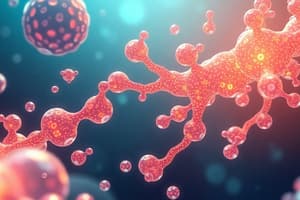Podcast
Questions and Answers
What is a characteristic of phosphatidylcholine-like molecules?
What is a characteristic of phosphatidylcholine-like molecules?
- They have a negative charge at pH 7
- They have no net charge on their head groups (correct)
- They contain sialic acid
- They have a net charge on their head groups
What is the type of bonding that attaches a fatty acid to the amino group of sphingosine in ceramides?
What is the type of bonding that attaches a fatty acid to the amino group of sphingosine in ceramides?
- Disulfide bond
- Amide bond (correct)
- Ester linkage
- Peptide bond
What is the general structure of glycosphingolipids?
What is the general structure of glycosphingolipids?
- Ceramide with phosphate groups
- Ceramide with sugar residues (correct)
- Glycerol with phosphate groups
- Glycerol with sugar residues
What is the functional group found in sphingomyelins that classifies them as phospholipids?
What is the functional group found in sphingomyelins that classifies them as phospholipids?
What type of glycosphingolipids have a single sugar connected to the ceramide backbone?
What type of glycosphingolipids have a single sugar connected to the ceramide backbone?
What is the role of sphingomyelins in animal cells?
What is the role of sphingomyelins in animal cells?
What is a characteristic of gangliosides that distinguishes them from globosides?
What is a characteristic of gangliosides that distinguishes them from globosides?
What is the primary function of gangliosides?
What is the primary function of gangliosides?
What is the structural similarity between ceramides and another type of lipid?
What is the structural similarity between ceramides and another type of lipid?
Where are glycosphingolipids primarily located in the cell membrane?
Where are glycosphingolipids primarily located in the cell membrane?
What is the term for lipids that contain a carbohydrate moiety?
What is the term for lipids that contain a carbohydrate moiety?
What is the term for the membranous sheath that surrounds and insulates the axons of some neurons?
What is the term for the membranous sheath that surrounds and insulates the axons of some neurons?
What is the backbone of glycerophospholipids?
What is the backbone of glycerophospholipids?
What is the structure of phosphatidylcholine?
What is the structure of phosphatidylcholine?
What is the function of sphingolipids in neurons?
What is the function of sphingolipids in neurons?
What is the difference between glycosphingolipids and sphingomyelins?
What is the difference between glycosphingolipids and sphingomyelins?
What is a ceramide?
What is a ceramide?
What is the main difference between storage lipids and membrane lipids?
What is the main difference between storage lipids and membrane lipids?
Study Notes
Sphingolipids
- Sphingolipids are a class of lipids that have a backbone of sphingosine, a long-chain amino alcohol, rather than glycerol.
- The simplest compounds of this class are ceramides, which consist of a fatty acid attached to the amino group of sphingosine via an amide bond.
- Ceramides are structurally similar to diacylglycerol and are the structural parents of all sphingolipids.
Ceramides
- Ceramides have a fatty acid attached to the amino group of sphingosine via an amide bond, rather than an ester linkage.
- They are the simplest compounds of the sphingolipid class.
Subclasses of Sphingolipids
- Sphingolipids can be divided into two subclasses: sphingomyelins and glycosphingolipids.
- Sphingomyelins contain phosphocholine or phosphoethanolamine as the polar head group and are classified as phospholipids.
- Glycosphingolipids have head groups with one or more sugars connected to the –OH at C-1 of the ceramide moiety.
Sphingomyelins
- Sphingomyelins are present in the plasma membranes of animal cells and are abundant in myelin, a membranous sheath that surrounds and insulates the axons of some neurons.
- They are structurally similar to phosphatidylcholine and have no net charge on their head groups.
Glycosphingolipids
- Glycosphingolipids occur largely in the outer face of the plasma membrane and have head groups with one or more sugars connected to the –OH at C-1 of the ceramide moiety.
- They do not contain phosphate.
- There are three types of glycosphingolipids depending on the number of sugar residues: cerebrosides, globosides, and gangliosides.
Cerebrosides and Globosides
- Cerebrosides have a single sugar (usually glucose or galactose) connected to the ceramide backbone.
- Glucocerebroside and galactocerebroside are examples of cerebrosides.
- Globosides have two or more sugars connected to the ceramide backbone.
- Cerebrosides and globosides have no net charge at pH 7.
Gangliosides
- Gangliosides have a complex carbohydrate portion (oligosaccharide) that can contain 4 or more sugars.
- They contain one or more residues of N-acetylneuraminic acid (also called sialic acid; Neu5Ac) at the termini.
- Deprotonated N-Acetylneuraminic acid gives gangliosides a negative charge at pH 7.
- Gangliosides play an important role in tissue and organ specificity and are especially abundant in nerve and brain cells.
Studying That Suits You
Use AI to generate personalized quizzes and flashcards to suit your learning preferences.
Description
This quiz covers the concepts of glycosphingolipids and sphingolipids in biochemistry, including their structure, functions, and types, as described in Lehninger's Principles of Biochemistry.

